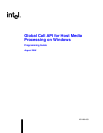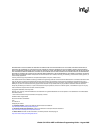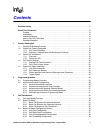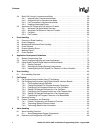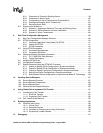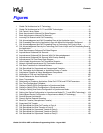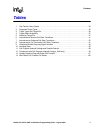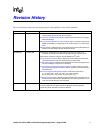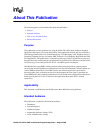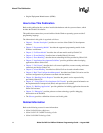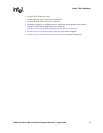
Global Call API for HMP on Windows Programming Guide – August 2006 7
Contents
Figures
1 Global Call Architecture for IP Technology . . . . . . . . . . . . . . . . . . . . . . . . . . . . . . . . . . . . . . . . 20
2 Global Call Architecture for E1/T1 and ISDN Technologies . . . . . . . . . . . . . . . . . . . . . . . . . . . 21
3 Call Control Library States. . . . . . . . . . . . . . . . . . . . . . . . . . . . . . . . . . . . . . . . . . . . . . . . . . . . . 23
4 Basic Asynchronous Inbound Call State Diagram . . . . . . . . . . . . . . . . . . . . . . . . . . . . . . . . . . . 40
5 Basic Asynchronous Inbound Call Scenario . . . . . . . . . . . . . . . . . . . . . . . . . . . . . . . . . . . . . . . 47
6 Incoming Call Scenario with Call Proceeding . . . . . . . . . . . . . . . . . . . . . . . . . . . . . . . . . . . . . . 48
7 Call Acknowledgement and Call Proceeding Done at the Application Layer. . . . . . . . . . . . . . . 49
8 Call Proceeding Done by the Application Layer with Minimum Information Configured . . . . . . 50
9 Call Acknowledgement and Call Proceeding Done at Technology Call Control Layer . . . . . . . 51
10 Call Acknowledgement Done by the Technology Call Control Layer and Call Proceeding Done by
the Application . . . . . . . . . . . . . . . . . . . . . . . . . . . . . . . . . . . . . . . . . . . . . . . . . . . . . . . . . . . . . . 52
11 Basic Asynchronous Outbound Call State Diagram . . . . . . . . . . . . . . . . . . . . . . . . . . . . . . . . . 54
12 Asynchronous Outbound Call Scenario. . . . . . . . . . . . . . . . . . . . . . . . . . . . . . . . . . . . . . . . . . . 58
13 Asynchronous Outbound Call Scenario With Call Acknowledgement . . . . . . . . . . . . . . . . . . . . 59
14 Asynchronous Outbound Call Scenario With Overlap Sending. . . . . . . . . . . . . . . . . . . . . . . . . 60
15 Asynchronous Call Tear-Down State Diagram . . . . . . . . . . . . . . . . . . . . . . . . . . . . . . . . . . . . . 61
16 User Initiated Asynchronous Call Termination Scenario . . . . . . . . . . . . . . . . . . . . . . . . . . . . . . 62
17 Network Initiated Asynchronous Call Termination Scenario . . . . . . . . . . . . . . . . . . . . . . . . . . . 63
18 Call State Transitions for Hold and Retrieve . . . . . . . . . . . . . . . . . . . . . . . . . . . . . . . . . . . . . . . 66
19 Call State Model for Supervised and Unsupervised Transfers . . . . . . . . . . . . . . . . . . . . . . . . . 68
20 Call Termination by the Network or Application During a Transfer . . . . . . . . . . . . . . . . . . . . . . 69
21 Architectural Diagram of Alarm Management Components . . . . . . . . . . . . . . . . . . . . . . . . . . . 98
22 Notification of First and Last Blocking Alarm . . . . . . . . . . . . . . . . . . . . . . . . . . . . . . . . . . . . . . 106
23 Default Behavior for Alarm Notification . . . . . . . . . . . . . . . . . . . . . . . . . . . . . . . . . . . . . . . . . . 107
24 Alarm Transmission . . . . . . . . . . . . . . . . . . . . . . . . . . . . . . . . . . . . . . . . . . . . . . . . . . . . . . . . . 108
25 Relationship of Customer Application, Global Call RTCM, and RTCM Parameters . . . . . . . . 110
26 Run Time Configuration Procedure . . . . . . . . . . . . . . . . . . . . . . . . . . . . . . . . . . . . . . . . . . . . . 118
27 Getting or Setting GCLib Configuration in Synchronous Mode . . . . . . . . . . . . . . . . . . . . . . . . 119
28 Getting or Setting CCLib Configuration in Synchronous Mode . . . . . . . . . . . . . . . . . . . . . . . . 120
29 Getting or Setting Line Device Configuration in Synchronous Mode. . . . . . . . . . . . . . . . . . . . 122
30 Setting Line Device Configuration in Asynchronous Mode (E1, T1 and ISDN Technology) . . 123
31 Setting Board Device Configuration in Asynchronous Mode (IP Technology). . . . . . . . . . . . . 124
32 Service Request Architecture . . . . . . . . . . . . . . . . . . . . . . . . . . . . . . . . . . . . . . . . . . . . . . . . . 128
33 Generic Service Request Operation . . . . . . . . . . . . . . . . . . . . . . . . . . . . . . . . . . . . . . . . . . . . 130
34 Blind Call Transfer (Unsupervised Transfer) . . . . . . . . . . . . . . . . . . . . . . . . . . . . . . . . . . . . . . 132
35 Supervised Call Transfer . . . . . . . . . . . . . . . . . . . . . . . . . . . . . . . . . . . . . . . . . . . . . . . . . . . . . 132
36 Call State Model for Blind Call Transfer at Party A . . . . . . . . . . . . . . . . . . . . . . . . . . . . . . . . . 134
37 Call State Model for Blind Transfer at Party B . . . . . . . . . . . . . . . . . . . . . . . . . . . . . . . . . . . . . 135
38 Call State Model for Supervised Transfer at Party A . . . . . . . . . . . . . . . . . . . . . . . . . . . . . . . . 136
39 Call State Model for Supervised Transfer at Party B . . . . . . . . . . . . . . . . . . . . . . . . . . . . . . . . 137
40 Call State Model for Supervised Transfer at Party C. . . . . . . . . . . . . . . . . . . . . . . . . . . . . . . . 138



